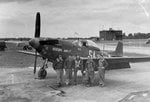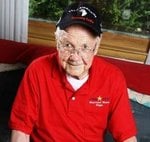Flight Lieutenant Aubrey Niner 
Flight Lieutenant Aubrey Niner , who has died aged 88, was in the middle of a bombing run over occupied France when he was forced to crash-land his bomber in the middle of the city of Lille.
It was the afternoon of Sunday July 19 1942 when Niner took off in his Boston bomber of No 88 Squadron to carry out a daylight attack against a power station at Lomme, not far from Lille. During the low-altitude run-in to the target, his aircraft was hit by flak which disabled the starboard engine and set fire to the wing. With the fire getting very close to a fuel tank, and seeing the wing buckling under the heat, Niner looked for somewhere to crash-land.
Over the centre of Lille, he spotted the only open area, the Champs de Mars park. With great skill he made a successful landing, attracting a sizeable crowd as he put down. Most of the aircraft's rudder had been shot away, and such was the difficulty of the manoeuvre that Niner was later commended by his captors. The crew survived without serious injury but, with the aircraft still on fire, they had to make a hasty exit – although Niner did remember to grab his hat.
Local firemen arrived to extinguish the flames before the aircraft was overrun by souvenir hunters and German intelligence personnel. The whole event – the crashed aircraft, the crew's capture and their initial incarceration – was photographed by a German serviceman. Some 30 years later Niner received copies of the pictures, which the photographer had passed to the British embassy in Bonn.
Aubrey Kelland Collins Niner was born at Southsea on June 10 1922 and educated at Sutton Valence School, near Maidstone. On his 18th birthday he volunteered for aircrew duties and joined the RAF in August 1940 to train as a pilot.
Niner joined No 88 in early 1942 to fly the American-built Boston medium bomber. The squadron specialised in daylight low-level attacks against communications targets, power stations and oil depots in the Low Countries and northern France. When he took off on July 19 it was his 16th operation.
After his capture and initial interrogation, he was sent to Stalag Luft III, scene of the Great Escape. In January 1945, during one of the coldest winters on record, the camp was evacuated as the Soviet armies approached, and he survived the "Long March" west.
He finally returned to England in May and was discharged from the RAF at the end of 1945.
Niner became managing director of the family firm, Harringtons, which marketed baby goods. In 1962 the company was awarded the Royal Warrant for its products. Niner subsequently became a divisional director within the Courtaulds Group and, later, chief executive of the National Children's Wear Association.
Aubrey Niner died on November 26. He married his second wife, Rosemary, in 1976, and she survives him with their two sons and a daughter from a previous marriage.
source: The Telegraph

Flight Lieutenant Aubrey Niner , who has died aged 88, was in the middle of a bombing run over occupied France when he was forced to crash-land his bomber in the middle of the city of Lille.
It was the afternoon of Sunday July 19 1942 when Niner took off in his Boston bomber of No 88 Squadron to carry out a daylight attack against a power station at Lomme, not far from Lille. During the low-altitude run-in to the target, his aircraft was hit by flak which disabled the starboard engine and set fire to the wing. With the fire getting very close to a fuel tank, and seeing the wing buckling under the heat, Niner looked for somewhere to crash-land.
Over the centre of Lille, he spotted the only open area, the Champs de Mars park. With great skill he made a successful landing, attracting a sizeable crowd as he put down. Most of the aircraft's rudder had been shot away, and such was the difficulty of the manoeuvre that Niner was later commended by his captors. The crew survived without serious injury but, with the aircraft still on fire, they had to make a hasty exit – although Niner did remember to grab his hat.
Local firemen arrived to extinguish the flames before the aircraft was overrun by souvenir hunters and German intelligence personnel. The whole event – the crashed aircraft, the crew's capture and their initial incarceration – was photographed by a German serviceman. Some 30 years later Niner received copies of the pictures, which the photographer had passed to the British embassy in Bonn.
Aubrey Kelland Collins Niner was born at Southsea on June 10 1922 and educated at Sutton Valence School, near Maidstone. On his 18th birthday he volunteered for aircrew duties and joined the RAF in August 1940 to train as a pilot.
Niner joined No 88 in early 1942 to fly the American-built Boston medium bomber. The squadron specialised in daylight low-level attacks against communications targets, power stations and oil depots in the Low Countries and northern France. When he took off on July 19 it was his 16th operation.
After his capture and initial interrogation, he was sent to Stalag Luft III, scene of the Great Escape. In January 1945, during one of the coldest winters on record, the camp was evacuated as the Soviet armies approached, and he survived the "Long March" west.
He finally returned to England in May and was discharged from the RAF at the end of 1945.
Niner became managing director of the family firm, Harringtons, which marketed baby goods. In 1962 the company was awarded the Royal Warrant for its products. Niner subsequently became a divisional director within the Courtaulds Group and, later, chief executive of the National Children's Wear Association.
Aubrey Niner died on November 26. He married his second wife, Rosemary, in 1976, and she survives him with their two sons and a daughter from a previous marriage.
source: The Telegraph




